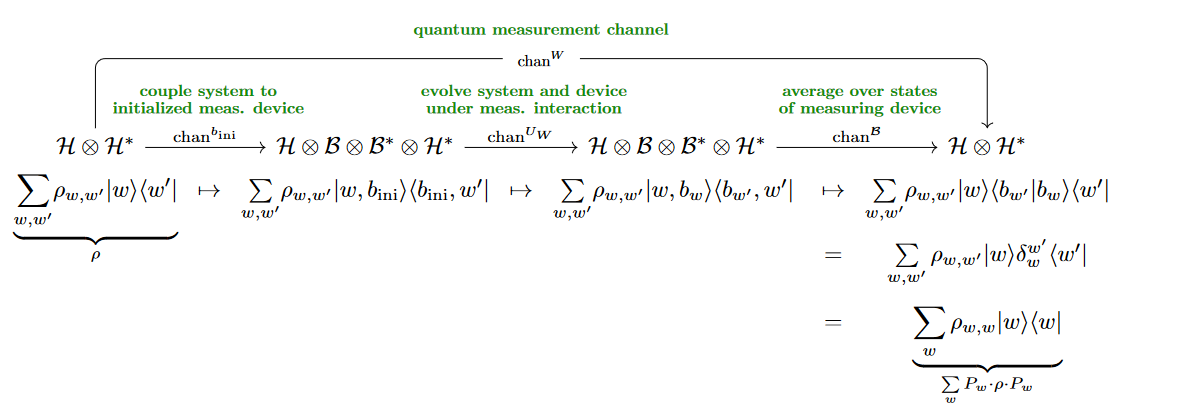nLab partial trace quantum channel
Context
Quantum systems
-
quantum algorithms:
Contents
Idea
For a finite-dimensional Hilbert space, the operation of partial trace over is a quantum channel
which represents the “operation” of averaging the mixed quantum states of the composite quantum system over the degrees of freedom of .
Properties
Environmental representation of quantum channels
The crux of dynamical quantum decoherence is that fundamentally the (time-)evolution of any quantum system may be assumed unitary (say via a Schrödinger equation) when taking the whole evolution of its environment (the “bath”, ultimately the whole observable universe) into account, too, in that the evolution of the total system is given by a unitary operator
after understanding the mixed states (density matrices) of the given quantum system as coupled to any given mixed state of the bath (via tensor product)
…the only catch being that one cannot — and in any case does not (want or need to) — keep track of the precise quantum state of the environment/bath, instead only of its average effect on the given quantum system, which by the rule of quantum probability is the mixed state that remains after the partial trace over the environment:
In summary this means for practical purposes that the probabilistic evolution of quantum systems is always of the composite form
This composite turns out to be a “quantum channel”
The realization of a quantum channel in the form (2) is also called an environmental representation (eg. Życzkowski & Bengtsson 2004 (3.5)).
In fact all quantum channels on a fixed Hilbert space have such an evironmental representation:
Proposition
(environmental representation of quantum channels)
Every quantum channel
may be written as
-
a unitary quantum channel, induced by a unitary operator
-
on a compound system with some (the “bath”), yielding a total system Hilbert space (tensor product),
-
and acting on the given mixed state coupled (tensored) with any pure state of the bath system,
-
followed by partial trace (averaging) over (leading to decoherence in the remaining state)
in that
Conversely, every operation of the form (2) is a quantum channel.
This is originally due to Lindblad 1975 (see top of p. 149 and inside the proof of Lem. 5). For exposition and review see: Nielsen & Chuang 2000 §8.2.2-8.2.3. An account of the infinite-dimensional case is in Attal, Thm. 6.5 & 6.7. These authors focus on the case that the environment is in a pure state, the (parital) generalization to mixed environment states is discussed in Bengtsson & Życzkowski 2006 pp. 258.
Proof
We spell out the proof assuming finite-dimensional Hilbert spaces. (The general case follows the same idea, supplemented by arguments that the following sums converge.)
Now given a completely positive map:
then by operator-sum decomposition there exists a set (finite, under our assumptions) inhabited by at least one element
and an -indexed set of linear operators
such that
Now take
with its canonical Hermitian inner product-structure with orthonormal linear basis and consider the linear map
Observe that this is a linear isometry
This implies that is injective so that we have a direct sum-decomposition of its codomain into its image and its cokernel orthogonal complement, which is unitarily isomorphic to summands of that we may identify as follows:
In total this yields a unitary operator
and we claim that this has the desired action on couplings of the -system to the pure bath state :
This concludes the construction of an environmental representation where the environment is in a pure state.
Remark
The above theorem is often phrased as “… and the environment can be assumed to be in a pure state”. But in fact the proof crucially uses the assumption that the environment is in a pure state. It is not clear that there is a proof that works more generally.
In fact, if the environment is taken to be in the maximally mixed state, then the resulting quantum channels are called noisy operations or unistochastic quantum channels and are not expected to exhaust all quantum channels.
Environmental representation of measurement channels
By the general theorem about environmental representations of quantum channels, every quantum channel on a quantum system may be decomposed as
-
coupling of to an environment/bath system ,
-
unitary evolution of the composite system ,
-
averaging the result over the environment states.
The way this works specifically for quantum measurement channels has precursor discussion von Neumann 1932 §VI.3 and received much attention in discussion of quantum decoherence following Zurek 1981 and Joos & Zeh 1985 (independently and apparently unkowingly of the general discussion of environmental representations in Lindblad 1975).
Concretely,
(we shall restrict attention to finite-dimensional Hilbert spaces not to get distracted by technicalities that are irrelevant to the point we are after)
if (we use bra-ket notation) denotes the initial state of a “device” quantum system then any notion of this device measuring the given quantum system (in its measurement basis , ) under their joint unitary quantum evolution should be reflected in a unitary operator under Zurek 1981 (1.1), Joos & Zeh 1985 (1.1.), following von Neumann 1932 §VI.3, review includes Schlosshauer 2007 (2.51):
-
the system remains invariant if it is purely in any eigenstate of the measurement basis,
-
while in this case the measuring system evolves to a corresponding “pointer state” :
for and distinct elements of an (in practice: approximately-)orthonormal basis for . (There is always a unitary operator with this mapping property (4), for instance the one which moreover maps and is the identity on all remaining basis elements.)
But then the composition of the corresponding unitary quantum channel with the averaging channel over is indeed equal to the -measurement quantum channel on (cf. eg. Schlosshauer 2007 (2.117), going back to Zeh 1970 (7)), as follows:

Related concepts
Last revised on September 24, 2023 at 16:04:54. See the history of this page for a list of all contributions to it.